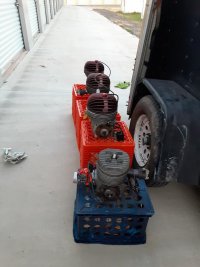Pete_Muller
Moderator
So today, I'm setting up squish band (thickness and angle), and cc's on a KT100. As I'm sneaking up on the dimension, I'm checking the smashed solder (stick it through the spark plug hole and turn the engine over by hand). As I've done for probably close to 45 years, I'm measuring it with either a set of calipers or a micrometer.
As I'm walking back to the lathe, I'm facing something I've owned for 30 years, and I've probably had access to one for 45 years. An optical comparator. It never occurred to me that I could just set the solder on the glass of the comparator, and actually look at the squish band on the comparator (and easily measure included angle and thickness).
It "only" took me 40 or 45 years to realize this.
PM

As I'm walking back to the lathe, I'm facing something I've owned for 30 years, and I've probably had access to one for 45 years. An optical comparator. It never occurred to me that I could just set the solder on the glass of the comparator, and actually look at the squish band on the comparator (and easily measure included angle and thickness).
It "only" took me 40 or 45 years to realize this.
PM


